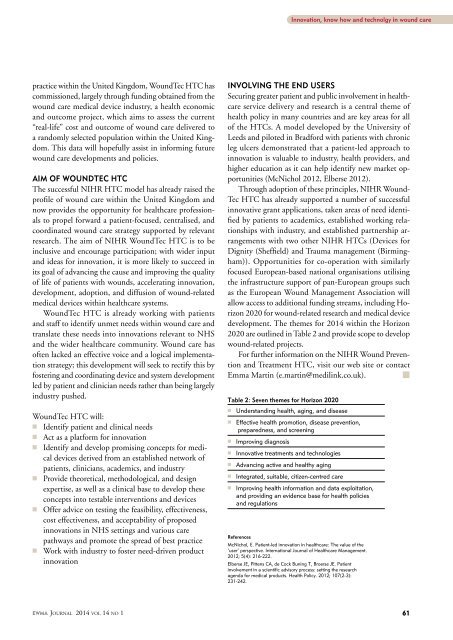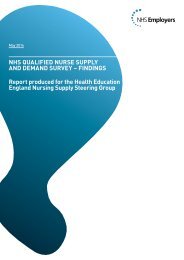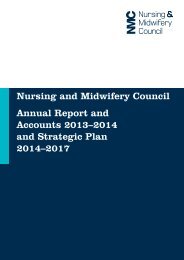Journal_1_2014_final_WEB
Journal_1_2014_final_WEB
Journal_1_2014_final_WEB
You also want an ePaper? Increase the reach of your titles
YUMPU automatically turns print PDFs into web optimized ePapers that Google loves.
Innovation, know how and technolgy in wound care<br />
practice within the United Kingdom, WoundTec HTC has<br />
commissioned, largely through funding obtained from the<br />
wound care medical device industry, a health economic<br />
and outcome project, which aims to assess the current<br />
“real-life” cost and outcome of wound care delivered to<br />
a randomly selected population within the United Kingdom.<br />
This data will hopefully assist in informing future<br />
wound care developments and policies.<br />
Aim of WoundTec HTC<br />
The successful NIHR HTC model has already raised the<br />
profile of wound care within the United Kingdom and<br />
now provides the opportunity for healthcare professionals<br />
to propel forward a patient-focused, centralised, and<br />
coordinated wound care strategy supported by relevant<br />
research. The aim of NIHR WoundTec HTC is to be<br />
inclusive and encourage participation; with wider input<br />
and ideas for innovation, it is more likely to succeed in<br />
its goal of advancing the cause and improving the quality<br />
of life of patients with wounds, accelerating innovation,<br />
development, adoption, and diffusion of wound-related<br />
medical devices within healthcare systems.<br />
WoundTec HTC is already working with patients<br />
and staff to identify unmet needs within wound care and<br />
translate these needs into innovations relevant to NHS<br />
and the wider healthcare community. Wound care has<br />
often lacked an effective voice and a logical implementation<br />
strategy; this development will seek to rectify this by<br />
fostering and coordinating device and system development<br />
led by patient and clinician needs rather than being largely<br />
industry pushed.<br />
WoundTec HTC will:<br />
n Identify patient and clinical needs<br />
n Act as a platform for innovation<br />
n Identify and develop promising concepts for medical<br />
devices derived from an established network of<br />
patients, clinicians, academics, and industry<br />
n Provide theoretical, methodological, and design<br />
expertise, as well as a clinical base to develop these<br />
concepts into testable interventions and devices<br />
n Offer advice on testing the feasibility, effectiveness,<br />
cost effectiveness, and acceptability of proposed<br />
innovations in NHS settings and various care<br />
pathways and promote the spread of best practice<br />
n Work with industry to foster need-driven product<br />
innovation<br />
Involving the end users<br />
Securing greater patient and public involvement in healthcare<br />
service delivery and research is a central theme of<br />
health policy in many countries and are key areas for all<br />
of the HTCs. A model developed by the University of<br />
Leeds and piloted in Bradford with patients with chronic<br />
leg ulcers demonstrated that a patient-led approach to<br />
innovation is valuable to industry, health providers, and<br />
higher education as it can help identify new market opportunities<br />
(McNichol 2012, Elberse 2012).<br />
Through adoption of these principles, NIHR Wound-<br />
Tec HTC has already supported a number of successful<br />
innovative grant applications, taken areas of need identified<br />
by patients to academics, established working relationships<br />
with industry, and established partnership arrangements<br />
with two other NIHR HTCs (Devices for<br />
Dignity (Sheffield) and Trauma management (Birmingham)).<br />
Opportunities for co-operation with similarly<br />
focused European-based national organisations utilising<br />
the infrastructure support of pan-European groups such<br />
as the European Wound Management Association will<br />
allow access to additional funding streams, including Horizon<br />
2020 for wound-related research and medical device<br />
development. The themes for <strong>2014</strong> within the Horizon<br />
2020 are outlined in Table 2 and provide scope to develop<br />
wound-related projects.<br />
For further information on the NIHR Wound Prevention<br />
and Treatment HTC, visit our web site or contact<br />
Emma Martin (e.martin@medilink.co.uk). m<br />
Table 2: Seven themes for Horizon 2020<br />
n Understanding health, aging, and disease<br />
n Effective health promotion, disease prevention,<br />
preparedness, and screening<br />
n Improving diagnosis<br />
n Innovative treatments and technologies<br />
n Advancing active and healthy aging<br />
n Integrated, suitable, citizen-centred care<br />
n Improving health information and data exploitation,<br />
and providing an evidence base for health policies<br />
and regulations<br />
References<br />
McNichol, E. Patient-led innovation in healthcare: The value of the<br />
‘user’ perspective. International <strong>Journal</strong> of Healthcare Management.<br />
2012; 5(4): 216-222.<br />
Elberse JE, Pittens CA, de Cock Buning T, Broerse JE. Patient<br />
involvement in a scientific advisory process: setting the research<br />
agenda for medical products. Health Policy. 2012; 107(2-3):<br />
231-242.<br />
EWMA <strong>Journal</strong> <strong>2014</strong> vol 14 no 1 61




